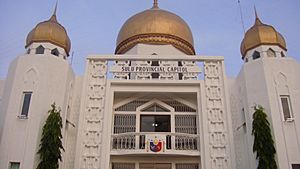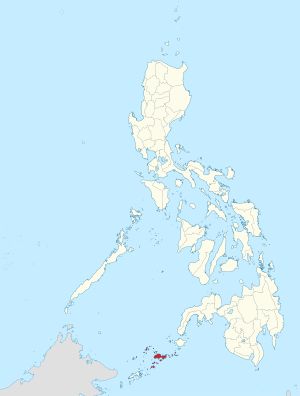Sulu facts for kids
Quick facts for kids
Sulu
|
|||
|---|---|---|---|
| Province of Sulu | |||

Sulu Provincial Capitol Building in Jolo
|
|||
|
|||

Location in the Philippines
|
|||
|
OpenStreetMap
|
|||
| Country | Philippines | ||
| Region | Bangsamoro Autonomous Region in Muslim Mindanao | ||
| Founded | March 10, 1917 | ||
| Capital |
|
||
| Government | |||
| • Type | Sangguniang Panlalawigan | ||
| Area | |||
| • Total | 1,600.40 km2 (617.92 sq mi) | ||
| Area rank | 66th out of 81 | ||
| Highest elevation
(Bud Dajo)
|
620 m (2,030 ft) | ||
| Population
(2020 census)
|
|||
| • Total | 1,000,108 | ||
| • Rank | 33rd out of 81 | ||
| • Density | 624.9113/km2 (1,618.513/sq mi) | ||
| • Density rank | 10th out of 81 | ||
| Divisions | |||
| • Independent cities | 0 | ||
| • Component cities | 0 | ||
| • Municipalities |
19
|
||
| • Barangays | 410 | ||
| • Districts | 1st and 2nd districts of Sulu | ||
| Time zone | UTC+8 (PHT) | ||
| ZIP code |
7400–7416
|
||
| IDD : area code | +63 (0)68 | ||
| ISO 3166 code | PH-SLU | ||
| Spoken languages | |||
| Income classification | 2nd class | ||
Sulu (in Tausūg: Wilāya sin Lupa' Sūg) is a special province in the Philippines. It is part of the Sulu Archipelago, a group of islands. Sulu is also part of the Bangsamoro Autonomous Region in Muslim Mindanao (BARMM).
The main city and capital of Sulu is Jolo. It is located on the island of the same name.
Contents
About Sulu Province
Sulu is an island province in the southwestern part of the Philippines. It is known for its rich history and unique culture. The province is made up of many islands and islets.
Geography and Location
Sulu is located in the Sulu Archipelago. This is a chain of islands between the large island of Mindanao in the Philippines and the island of Borneo. The province covers about 1,600 square kilometers (618 square miles). The highest point in Sulu is Bud Dajo, which is 620 meters (2,034 feet) tall.
People and Culture
The people of Sulu are mostly from the Tausug group. They speak the Tausug language. Other languages spoken include Sama, Tagalog, and English. The culture of Sulu is very rich. It has been shaped by its history as a center of trade and a powerful sultanate.
Government and Leadership
Sulu is led by a Governor, who is the head of the province. The current Governor is Abdusakur M. Tan. There is also a Vice Governor, Abdusakur A. Tan II. The province also has a traditional leader called a Sultan. The Sultan is the head of the Sultanate of Sulu. The Sultanate is a historical kingdom that once ruled these islands. Its traditional seat was in Maimbung.
Towns and Communities
Sulu province has 19 different towns, called municipalities. These include:
- Banguingui
- Hadji Panglima Tahil
- Indanan
- Jolo
- Kalingalan Caluang
- Lugus
- Luuk
- Maimbung
- Omar
- Panamao
- Pandami
- Panglima Estino
- Pangutaran
- Parang
- Pata
- Patikul
- Siasi
- Talipao
- Tapul
Each of these towns has smaller areas called barangays. There are 410 barangays in total across Sulu.
History of Sulu
Sulu has a long and interesting history. It was once home to the powerful Sultanate of Sulu. This sultanate played a big role in trade and politics in Southeast Asia for many centuries.
The Sultanate of Sulu
The Sultanate of Sulu was a Muslim state. It ruled over many islands in the Sulu Sea. It also controlled parts of Borneo. The Sultanate was very important for trade. It connected different parts of Asia. The palace of the Sultan, called Daru Jambangan, was in Maimbung. It was sadly destroyed by a typhoon.
Becoming a Province
Sulu officially became a province of the Philippines on March 10, 1917. This was after a long period of changes in the region. Today, it is part of the Bangsamoro Autonomous Region in Muslim Mindanao. This region has its own special government.
Images for kids
-
Daru Jambangan, also known as the Palace of Flowers, in Maimbung. This was the home of the Sultanate of Sulu's ruler for many years before it was destroyed.
See also
 In Spanish: Provincia de Joló para niños
In Spanish: Provincia de Joló para niños







